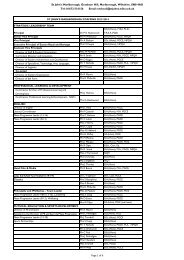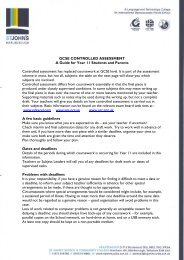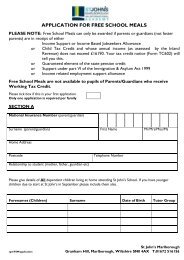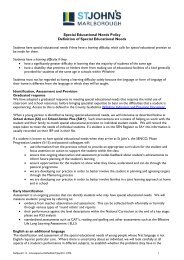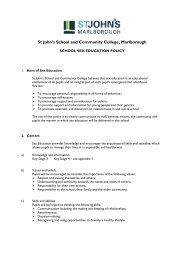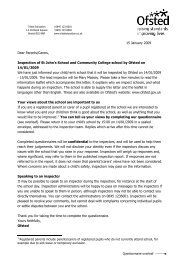Geography Exam Techniques â general hints and tips
Geography Exam Techniques â general hints and tips
Geography Exam Techniques â general hints and tips
Create successful ePaper yourself
Turn your PDF publications into a flip-book with our unique Google optimized e-Paper software.
• Questions worth 1-3 marks are marked per correct point, so the more correct points you make the<br />
higher your mark will be.<br />
• Questions worth 4-8 marks will require longer answers!<br />
These answers are marked according to the 'level of response' that you give to the question. The examiner<br />
must first decide which level your answer falls into <strong>and</strong> then award you a mark within this level. If you do<br />
not meet the requirements of the higher level, the examiner cannot award you those marks. The higher<br />
your level, the higher your mark will be.<br />
Level 1: Basic<br />
Knowledge of basic information<br />
Simple underst<strong>and</strong>ing<br />
Few links; limited detail; uses a limited range of specialist terms<br />
Limited evidence of sentence structure<br />
Frequent spelling, punctuation <strong>and</strong> grammatical errors<br />
Level 2: Clear<br />
Knowledge of accurate information<br />
Clear underst<strong>and</strong>ing<br />
Answers have some linkages; occasional detail/exemplar; uses some specialist terms where appropriate<br />
Clear evidence of sentence structure<br />
Some spelling, punctuation <strong>and</strong> grammatical errors<br />
Level 3: Detailed<br />
Knowledge of accurate information appropriately contextualised <strong>and</strong>/or at correct scale Detailed<br />
underst<strong>and</strong>ing, supported by relevant evidence <strong>and</strong> exemplars<br />
Well organised, demonstrating detailed linkages <strong>and</strong> the interrelationships between factors Range of ideas<br />
in logical form; uses a range of specialist terms where appropriate<br />
Well structured response with effective use of sentences<br />
Few spelling, punctuation <strong>and</strong> grammatical errors<br />
Note: Your answer does not have to be perfect to score full marks. In fact, the mark scheme says that 'a<br />
perfect answer is not usually expected, even for full marks'.<br />
<strong>Exam</strong> comm<strong>and</strong> words<br />
Study = look very carefully at the resource - this is not a question that you have to answer but an<br />
instruction that needs to be followed before you answer the following questions. It is known as the stem<br />
part of the question.<br />
Complete = this might be filling in a table, finishing off a graph using data you have been given, choosing<br />
words from a list to fill in the missing gaps in a paragraph or circling the correct answer from a range of<br />
options. Make sure that you circle or tick the correct number of items!<br />
Name = just give the name - there is no need to write anything else e.g. Name the Oceans marked on the<br />
map at A <strong>and</strong> B. Just write 'Pacific Ocean <strong>and</strong> Atlantic Ocean' (or whatever they are!) not 'The ocean<br />
named on the map at A is the Pacific Ocean <strong>and</strong> the ocean named on the map at B is the Atlantic Ocean'.<br />
Label = this kind of question often asks you to add a name, description or explanation to a text-box on a<br />
photograph or diagram.<br />
Describe = say what you see (without giving reasons) - are there any patterns or trends? If you are<br />
describing a graph, make sure that you include figures in your answer.




